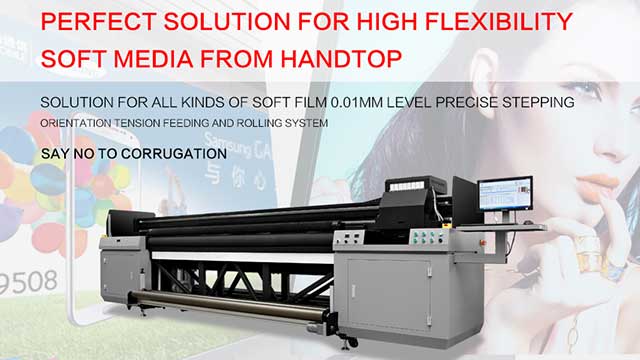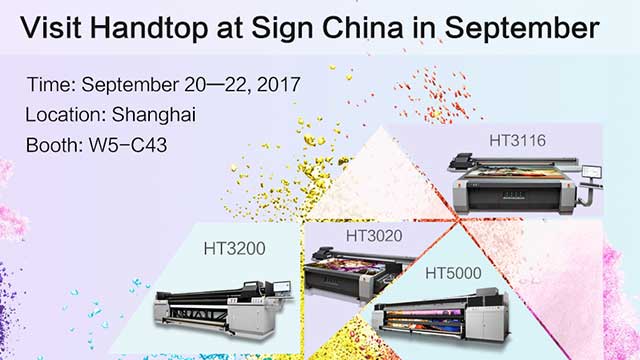info-handtop@hanglorygroup.com+86-0755-27960460
Chineseinfo-handtop@hanglorygroup.com+86-0755-27960460
ChineseHandtop digital provides professional and close technical advisory services, including full range of products consulting and technical advices,services,etc..
Please fill in the information, we will reply you within 36 hours.

Exclusive interview of Handtop HT3200RTR project R&D chief engineer
Soft film is widely used in many areas, the high-end advertisements in shopping malls and metros are mostly made by soft film. HT3200RTR is a roll to roll model made by Handtop focused on roll medias. This model has a unique solution for soft film printing, in some way, it is a world-class top end printer for soft film.
We interviewed the chief engineer of the R&D project for this model, Jiawang Rao, and bring you the specialty and figures for this model against soft film printing.
What’s the difference between soft film and other media?
Rao: There are lots of soft films, the key point is the thickness of the media. Some very thin soft film can reach to 0.18mm. These types of soft film share one common figure, that is, the thinner, the better clarity, moreover, the cost will be lower. Most advertising companies are prefer thinner types when choosing the media.
But the soft film is very unique compared to other medias due to the material, it is very suitable for backlit application in some high-end locations such as metro and shopping malls, also ceiling application in some top-end areas, etc. Backlit application can present vivid image with higher precision. For example, if you want to present the taste of KFC chicken wings by advertisement, by using soft film backlit solution, you can see even the bitten marks and the salt-and-pepper on the wings clearly.
What are the problems so hard for us to solve with soft film printing?
Rao: Let’s first talk about a pair of real existed conflicts. As I said, the soft film backlit application need to perform the high precision of the image. But normal roll to roll machines always have a lot of factors will affect the precision of the image during the printing process of soft film. This is the major conflict.
These factors are mostly decided by the figures of the material itself. Thinner soft film are more popular. But since it is too thin, it is easy to be distorted by the tension when printing. This is why faulty stepping always happening. The stepping is essential to the performance, precise stepping allows us to present more details on the image.
Other problem is the corrugation during the stepping. Homer textile, as one of the sister companies of Handtop Tech, they have a model for paper printing which is used in sublimation industry. This is also with roll to roll mechanics and they can print very smoothly. But for soft film, it is totally different concept. Because of the temperature is too high for soft film, also in order to reach certain precision and color, the ink density is usually very high, these 2 reasons are what causes the corrugation.
The stepping precision and the corrugation, these 2 problems are what affected the soft film output performance.
Are these difficulties the common problems in the industry?
Rao: Yes. As far as we know, all the roll to roll devices on the market will face the same difficulty. They may get good performance on other medias, but when the media change into soft film, they will not be so sure about it.
Flatbed printer and hybrid printer (printers with both platform and roll to roll mechanics) would also face some problems in printing soft film. The flatbed printer can’t print large format soft film, corrugation will also trouble the hybrid printer. In some terms, there is no perfect solution for soft film printing.
But the problems of printing soft film must be solved, this is decided by the market demands. The development of advertising industry is too fast, if a customer requests to print a length of 15m or even 50m on the media, what should we do? It can only be solved by the roll to roll machine. Now this market is growing bigger, many advertising companies saw the opportunity, and if we catch this chance, that will help us to get market share.
When did Handtop start thinking about these questions?
Rao: I think good R&D team should be stable, no matter for the new applications or the development of a model itself, steady should be important. Many Handtop models are launched very stably, and been through years of testing, such as HT2512. Many advertising companies and individuals in this industry, when they are looking for a printer, the first question from them is always whether Handtop has the solutions accordingly.
The project for roll to roll models had been started very early in Handtop, but we did not rush to catch up the tide. There were lots of reasons, but the ultimate goal is to ensure we get mature application with the printer. Handtop is belong to the high-end manufacturers, so there is more to consider, such as the stepping precision and the tension against the flexibility of the soft film.
If only for the launch of roll to roll models, we would have done it, because the HM1800P from Homer(sister company of Handtop) launched long ago, which is a roll to roll model and got very good feedback on the market.
Are these problems solved?
Rao: When we start the HT3200 project, we already solved many problems in advance, but we still take great precaution with every details and solve the problems we encountered with big effort. Now the problems of soft film are completely solved by us. After multiple tests and comparisons, we can say it proudly that this model is the best printer for soft film printing.
We did not only solve the corrugation and stepping problem, we can also ensure the media can be cut off during the printing process.
What are the solutions for these problems?
Rao: To solve the problems of printing soft film, 3 core questions should be answered as we mentioned, delivering precision, corrugation and the deviation.
Here we say delivering is not entirely equal to stepping. Because of the flexibility of the material, even if we can get perfect precision with Y stepping, the delivering precision would still be a problem. Of course, accurate stepping is necessary. HT3200 is equipped with high precise reducer, and using front roller to drive. This can ensure an accurate stepping while transform the tension into the pulling force which will make the substrate surface as smooth as possible.
To solve the distortion problem, we developed a set of constant-tension system. This will get every point of printing surface with average tension during the delivering. Then the delivering and the stepping of the roller will keep the same pace, finally, we can get accurate delivering.
How do you feel about this R&D process, it must very hard?
Rao: Handtop Tech represents the highest level of UV industry in China, for these questions, it is our responsibility to solve them. We devoted great efforts to conquer these difficulties, for now, we should be leading the technology breakthrough on this problem in the entire UV printing device industry. I feel proud when I look back.
Thinking about the needs for the massive soft film UV printing on the market, this breakthrough will bring benefit for many advertising companies. Because they will be confident when facing large format soft film printing orders and without doubts any more. This also fulfilled us.

Thanks for your recognition, for better service, please provide below information.